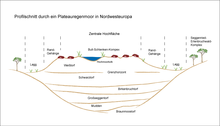Bog outbreak

A swamp eruption is the sudden break-up of a bulging high moor from which a landslide pours out, consisting of moor oversaturated with water. The moor can sometimes flow away for several kilometers and, depending on the environment, cause greater devastation .
The surface of raised bogs grows steadily upwards in the course of their development and can under certain circumstances also grow high above the surrounding shoreline. Inside the bog, a mixture of sphagnum peat saturated with water accumulates , the surface forms a relatively dry skin that keeps the whole structure in shape. By a disturbance of the unstable structure, for example by accumulating gases or static instability, this skin can break and the liquid contents in the form of a Mure release or mud avalanche. Occasionally, bog outbreaks can also be triggered by human intervention in the bog, such as the 2003 Derrybrien bog eruption in Ireland , in which 450,000 m³ of emerging bog uprooted trees in a forest area, rolled down buildings and caused fish to die in a river. In Germany, there is evidence of an eruption from Oldenbrok (Wesermarsch district) from the night of November 8th to 9th, 1764, which caused severe damage to the surrounding grain fields and buried drainage ditches. Another bog outbreak occurred in autumn 1793 near Leezdorf (district of Aurich).
Bog outbreaks are a phenomenon that can be observed particularly frequently in Ireland and England; from Ireland alone around 38 bog outbreaks were recorded up to 1995. In 1771, an eruption of the Solway Moss devastated an area of 200 hectares. In 1708, about three million cubic meters of bog from Woodfield Bog near Clara in County Offaly, Ireland, buried large areas up to twelve meters high.
See also
- landslide
- Solifluction (floor tiling)
- Mass movement (geology)
- Settlement flow
literature
- Hans Murawski: Keyword: swamp eruption . In: Geological Dictionary / Hans Murawski / Wilhelm Meyer . Spectrum, Akad. Verl., Heidelberg 2010, ISBN 978-3-8274-1810-4 , pp. 112 ( Google Books ).
Individual evidence
- ↑ EU court rules against Ireland on Derrybrien RTE News (accessed June 28, 2011)
- ↑ Friedrich Arends (1826): Painting of storm surges from 3rd to 5th February 1825. Bremen: p. 23
- ↑ Friedrich Arends: Painting of the storm surges from 3.-5. February 1825 . Kaiser, Bremen 1826, p. 23 .
- ^ Wijnand van der Sanden : Mummies from the moor. The prehistoric and protohistoric bog bodies from northwestern Europe . Batavian Lion International, Amsterdam 1996, ISBN 90-6707-416-0 , pp. 23 (Dutch, original title: Vereeuwigd in het veen . Translated by Henning Stilke).
